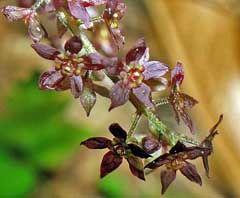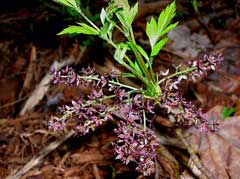 |
|
commons.wikimedia.org/wiki/User:TheAlphaWolf |
 |
| commons.wikimedia.org/wiki/User:TheAlphaWolf |
Translate this page:
Summary
Physical Characteristics

 Xanthorhiza_simplicissima is a deciduous Shrub growing to 1 m (3ft 3in) by 3 m (9ft) at a fast rate.
Xanthorhiza_simplicissima is a deciduous Shrub growing to 1 m (3ft 3in) by 3 m (9ft) at a fast rate.
See above for USDA hardiness. It is hardy to UK zone 6. It is in flower from March to April. The species is hermaphrodite (has both male and female organs).
Suitable for: light (sandy), medium (loamy) and heavy (clay) soils. Suitable pH: mildly acid soils. It can grow in full shade (deep woodland) semi-shade (light woodland) or no shade. It prefers moist or wet soil.
UK Hardiness Map
US Hardiness Map
Synonyms
X. apiifolia. Zanthorrhiza apiifolia.
Plant Habitats
Edible Uses
References More on Edible Uses
Medicinal Uses
Plants For A Future can not take any responsibility for any adverse effects from the use of plants. Always seek advice from a professional before using a plant medicinally.
The root is astringent and a blood tonic[222]. A tea made from the roots is used to treat mouth ulcers[213], stomach ulcers, colds, jaundice etc[222, 257]. An infusion of the roots has also been used to treat piles, though the report does not specify if it is used internally or externally[257]. Some caution is advised in the use of this plant, see the notes above on toxicity. The root contains the alkaloid 'berberine' which is used for its tonic properties and for digestive disorders[213]. Berberine is anti-inflammatory, astringent, haemostatic, antispasmodic, immuno-stimulant, uterine tonic and antimicrobial[222]. It stimulates the secretion of bile and bilirubin and may be helpful in correcting high tyramine levels in people with liver cirrhosis[222].
References More on Medicinal Uses
The Bookshop: Edible Plant Books
Our Latest books on Perennial Plants For Food Forests and Permaculture Gardens in paperback or digital formats.

Edible Tropical Plants
Food Forest Plants for Hotter Conditions: 250+ Plants For Tropical Food Forests & Permaculture Gardens.
More

Edible Temperate Plants
Plants for Your Food Forest: 500 Plants for Temperate Food Forests & Permaculture Gardens.
More

More Books
PFAF have eight books available in paperback and digital formats. Browse the shop for more information.
Shop Now
Other Uses
A yellow dye is obtained from the root[46, 61]. The entire plant can be crushed to yield a yellow dye[257]. A good ground cover for damp semi-shaded positions[11, 200]. Plants should be spaced about 1.2 metres apart each way[208].
Special Uses
References More on Other Uses
Cultivation details
Requires a moist acid soil in sun or part shade[184]. Prefers shade or semi-shade[188]. Succeeds in any moist fertile soil according to other reports[1, 182, 200]. Hardy to about -20°c[184]. Plants can spread considerably by means of suckers[182], especially when they are growing in a light soil[208]. A greedy plant, inhibiting the growth of nearby plants, especially legumes[54].
References Carbon Farming Information and Carbon Sequestration Information
Temperature Converter
Type a value in the Celsius field to convert the value to Fahrenheit:
Fahrenheit:
The PFAF Bookshop
Plants For A Future have a number of books available in paperback and digital form. Book titles include Edible Plants, Edible Perennials, Edible Trees,Edible Shrubs, Woodland Gardening, and Temperate Food Forest Plants. Our new book is Food Forest Plants For Hotter Conditions (Tropical and Sub-Tropical).
Shop Now
Plant Propagation
Seed - best sown in a cold frame as soon as it is ripe in the autumn[200]. Sow stored seed in a cold frame in late winter. When they are large enough to handle, prick the seedlings out into individual pots and grow them on in the greenhouse for at least their first winter. Plant them out into their permanent positions in late spring or early summer, after the last expected frosts. Division in the autumn or late winter[11].
Other Names
If available other names are mentioned here
Native Range
NORTHERN AMERICA: Hispaniola, Anguilla, Antigua and Barbuda (Antigua), Bahamas, Cuba, Dominica, St. Kitts and Nevis (Nevis), Martinique, United States (Puerto Rico, Virgin Islands, U.S.), Virgin Islands (British) (Tortola) United States (West Virginia), United States (Alabama, Florida (northwest), Georgia, Kentucky (east), Louisiana, Maryland (east), North Carolina, South Carolina, Virginia, Mississippi, Tennessee, Texas)
Weed Potential
Right plant wrong place. We are currently updating this section.
Please note that a plant may be invasive in one area but may not in your area so it’s worth checking.
Conservation Status
IUCN Red List of Threatened Plants Status :

Growth: S = slow M = medium F = fast. Soil: L = light (sandy) M = medium H = heavy (clay). pH: A = acid N = neutral B = basic (alkaline). Shade: F = full shade S = semi-shade N = no shade. Moisture: D = dry M = Moist We = wet Wa = water.
Expert comment
Author
Marshall.
Botanical References
11200270
Links / References
For a list of references used on this page please go here
Readers comment
| Add a comment |
|
If you have important information about this plant that may help other users please add a comment or link below. Only comments or links that are felt to be directly relevant to a plant will be included. If you think a comment/link or information contained on this page is inaccurate or misleading we would welcome your feedback at [email protected]. If you have questions about a plant please use the Forum on this website as we do not have the resources to answer questions ourselves.
* Please note: the comments by website users are not necessarily those held by PFAF and may give misleading or inaccurate information.
To leave a comment please Register or login here All comments need to be approved so will not appear immediately.
|
Subject : Xanthorhiza_simplicissima
|
|
|
|